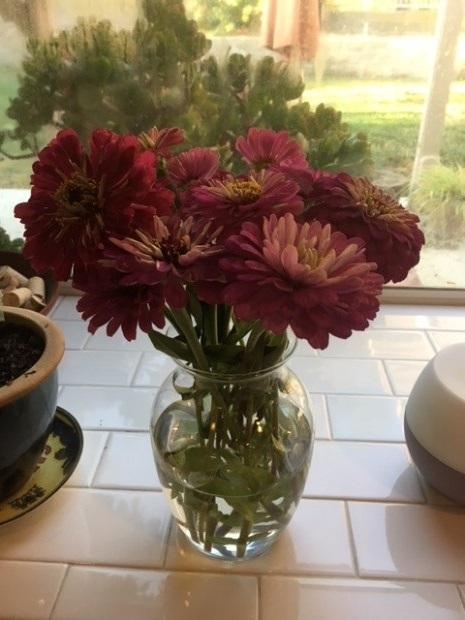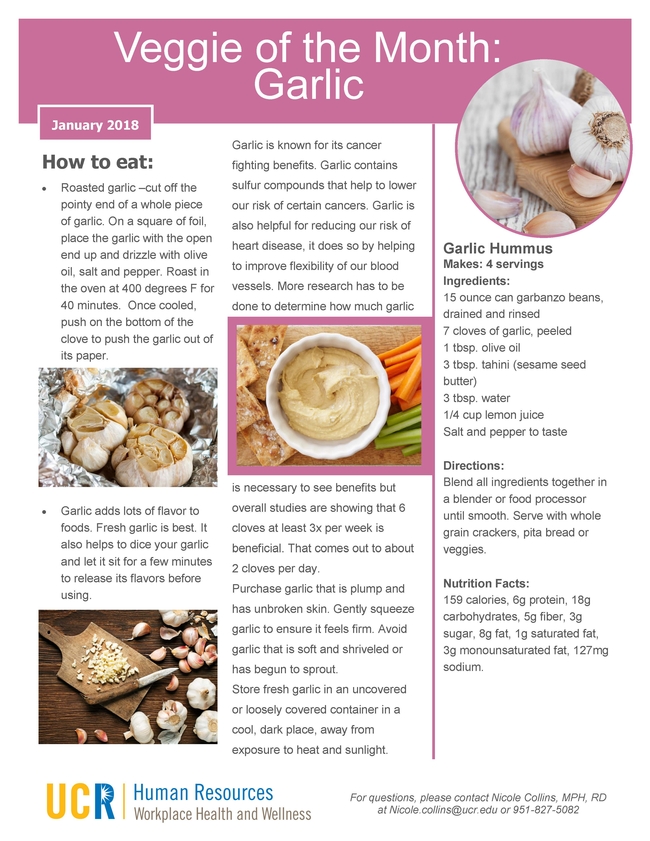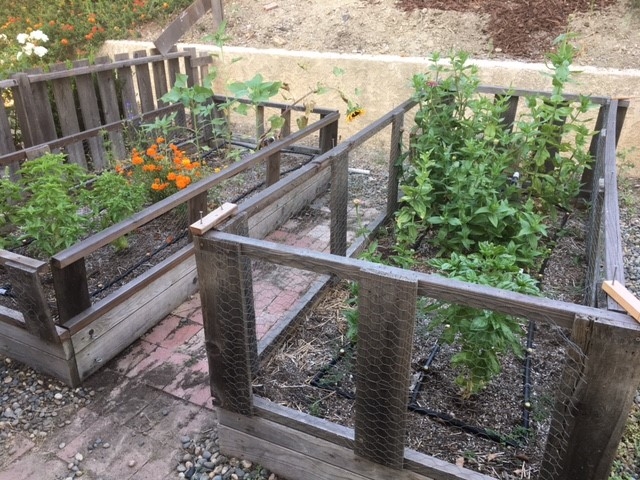- Author: Michael Bains
Garlic and kale are two popular vegetables with many health benefits. As a gardener, you can be harvesting kale right now, with kale being a winter grown veggie. Garlic, as anyone who's driven through Gilroy, California in June and July will know, is a summertime vegetable. However, due to its long growing time, garlic is normally planted in October and November to give it plenty of time to turn into a bulb that can be harvested.
In celebration of these two great veg, we're offering some advice on how to prepare them. Hopefully, this will get you motivated to give them a try and maybe get some going in your own garden.
January 2018 - Veggies of the Month
- Author: Deanna Cook
Editor's Note: In the spring, Deanna joined Urban Farm on The Urban Farm Podcast to discuss kids and farmer's markets! Listen to the podcast episode here.
One of the great pleasures of spring's arrival is the bounty of fresh foods and flavors we've been hungry for all winter long. Depending on where you live, the farmers' markets in your town may be starting to open up for the season. 
1. Turn shopping into a food-filled scavenger hunt. Before you head to the farmers' market, download these printable activities from Farmers' Market Create-and-Play Activity Book and take the scavenger hunt list along to turn your shopping experience into a learning adventure. Accompany children as they search for foods that grow underground (say, potatoes) or foods with seeds you can eat (peas in a pod). This activity will familiarize young shoppers with the wide range of offerings — from foods and flowers to handmade goods — grown or produced in your region.
2. Meet the farmers. As you walk around the market, stop by as many different booths as you can. Encourage children to say hello to the farmers and to try free samples set out for them to taste. When you or your children encounter an unfamiliar vegetable (such as kohlrabi or fennel), ask the farmer how he or she likes to eat it or cook with it. Don't forget to introduce your children to the dairy farmers and buy butter and eggs to take home, too.
3. Eat the Rainbow. Give kids a say in what you buy! Ask them to pick out some colorful fruits and veggies to bring home. (Use the Eat a Rainbow activity sheet for a list of foods to try.) Explain that foods of different colors provide different vitamins and nutrients their bodies need. At home, have them keep track of what they eat over the course of the week by posting the sheet on the fridge.
4. Get cooking! Help your kids pick out a few recipes you can cook together using their farmers' market finds. For kid-friendly, farm-to-table recipes, check out the salads and plant-based recipes in Cooking Class.
5. Recreate the spirit of the farmers' market at home. For a rainy day activity, set up a creative play area modeled after a real farmers' market. Set out pretend fruits and veggies, play money, shopping bags or baskets, and shopping lists on a table or wooden crates. Take turns pretending to be a farmer selling produce and a customer buying it. Then step back and let your little ones' imaginations take over.
6. Cultivate young growers. Take inspiration from your farmers' market field trip and have kids help with planting a vegetable garden in your yard or in pots and containers. You can pick up starter plants at the market or plant carrots, lettuces, and radishes from seed.
As the kids shop, play, and eat, they'll learn important classroom and life skills, such as identifying the names of fruits and vegetables, practicing addition and subtraction, and making healthy food choices. For Farmers Market lesson plans aligned to Common Core curriculum standards, download this educator's guide and add a learning element to your children's farmers market adventures!
XX
- Author: Michael Bains
The Rancho Santa Ana Botanic Garden (RSABG) is an 86-acre (34.8 hectare) garden in Claremont, California surrounded by the Claremont Colleges. It is roughly 35 miles east of Los Angeles and is my favorite botanic garden in Southern California. The focus of the garden is on California natives and contains natives starting from southern Oregon to western Nevada and extends well south into Baja California.
The garden was originally founded in 1927 by Susanna Bixby Bryant, who established the garden on 200 acres set aside on her family's Orange County ranch and has always been focused on emphasizing California flora.
In 1951 the garden moved to its present location in Claremont which is in Los Angeles County. This was also the time the garden became affiliated with The Claremont Colleges, a relationship that continues today and offers graduate degrees in botany. The garden contains about 2,000 taxa of the approximately 6,000 native plant taxa in California.
Upon arriving at the garden, you are immediately met in the parking lot by several California native trees giving much needed shade during the summer months. Near to my heart are two California Black Walnuts (Juglans californica) shading a short walkway leading to the nursery. They are near to me as I have recently planted one in my own garden in a section I'm devoting to California natives. They are, also, endangered, as their natural habitats become more and more encroached upon by development and grazing.
The garden is broken into 3 main areas. The Indian Hill Mesa is a flat-topped clay hill that sits a short uphill walk above the rest of the garden. Below the Mesa, is an area that runs to the east and leads to the third section that I lovingly refer to as the “North 40”, even though it's 55 acres (22.2 hectares). This area is the largest area and sits the furthest from the entrance.
The garden entrance is just below the Indian Hill Mesa. Here you are met with the beginnings of the desert garden which opens to the west to Fay's Wildflower Meadow. The meadow contains numerous types of wildflowers and is normally in full bloom starting in midwinter into the spring. Unfortunately, due to our recent drought, the meadow has not been able to reach its full glory in the recent past, even leading the garden to give this area supplemental watering. Many California wildflowers, such as California poppy (Eschscholzia californica), Lupine (Lupinus albifrons) and Mariposa lily (Calochortus clavitus) require a normal or even excessively heavy rainy season to bloom. California finally received a very wet winter to bring us officially out of our drought and created the first “super bloom” in a great while.
Continuing past Fay's Meadow Garden is the desert garden. Here numerous California desert natives can be found from the Mojave Desert down south into Baja California. There is a network of footpaths running through this area to explore different flora. The area contains Cylindropuntia acanthocarpa with its heavily spiked “clubs” and prickly pear cactus (Opuntia x vaseyi) among other delights. A little further back is the palm oasis consisting of a forest of California fan palms (Washingtonia filifera) surrounding a very small pond.
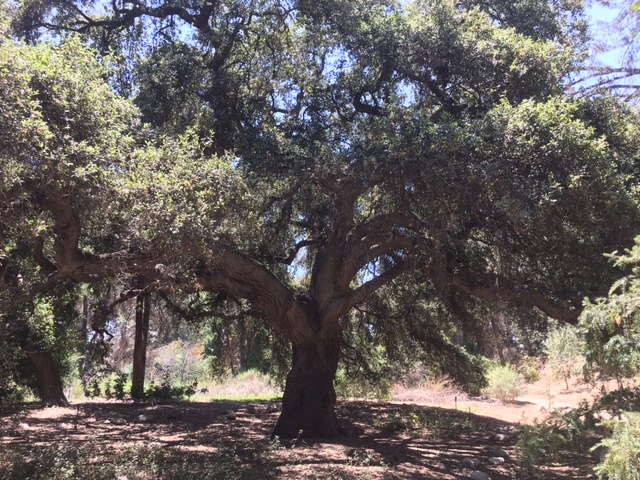
Past the Majestic Oak lies the northern 55 acres of the garden. This is a less cultivated area which allows for a much better sense of how the plants would look in the wild. Since there is minimal supplemental watering done, the best time to see this area is in the winter, especially after we have received some rain that begins, normally, in November.
The various plant communities are well marked; although, it is surprising how noticeable it can be at times moving from one community to the next. The area moves between Southern Chaparral, Foothill Woodlands, Northern Juniper Woodlands, Northern California Chaparral, amongst others. There are also more specific plant communities, such as Torrey Pines (Pinus torreyana),Joshua Trees (Yucca brevifolia), Junipers (Juniperus occidentalis) and my personal favorite of the Boojum Tree (Fouquieria columnaris). I'm quite certain the Boojum tree has appeared in at least one Dr. Seuss story. Most likely with Sam I am sitting on top of it. It's a single thick trunk that resembles a candle with short pencil-like branches sprouting from it. It's quite a sight.
Climbing back up from the Plant Communities is the Indian Hill Mesa. This area prior to colonization was inhabited by the Serrano. The Serrano people lived in the San Bernardino Mountains, which the garden is at the base of, and in the southern Mojave Desert. The Mesa contains the main structures of the garden and is where most of the garden's organized activities take place.
Throughout the summer, the Butterfly Pavilion is in this area, where native California butterflies are maintained for educational purposes as well as for sheer enjoyment. There is a party where the pavilion is opened and the butterflies released later in the summer. It is a lot of fun, just be sure to watch your step as butterfly squishing is frowned upon.
The Cultivar Garden is, as the name implies, an area that is a bit more “gardened” than other areas. It is meant to show some of the possibilities available with native California plants in a home garden. One of the areas of resistance that I have come across when speaking of natives is the perception that they do not look good in the garden. I think many people see them as weeds, since in their native habitat they go dormant in the summertime and are assumed, by many, to be dead. Combine this with our large nurseries that push non-natives onto the public, even invasive species, and our native flora is becoming scarce indeed. Showing what can be accomplished with minimal summer watering is part of the garden's public education.
The Mesa also contains Benjamin Pond, which is a small pond home to turtles, some koi, and whatever wildlife might need a drink of water. It's not uncommon to run across squirrels, rabbits and the occasional coyote wandering through the garden and the pond offers a water source, as well as, a nice cool place to sit after wandering around the garden on a hot summer day.
The Rancho Santa Ana Botanic Garden is also a research garden housing the largest store of California native seeds in the world. They conduct research, both in the laboratory and in the field, and are not immune to creating new cultivars of California natives. The research library contains nearly 40,000 volumes covering a wide range of topics. The garden is not supported by tax payer dollars and relies on grants, donations, admission charges and the Grow Native Nursery, which is open from October to May, when the weather is tolerable for planting.
This garden is quite a gem with a noble mission to save, cultivate and educate with regards to California native plants. I for one support the garden as much as I can and look forward to many years of watching it continue to grow.
- Author: Michele Martinez
Whether we live in the city, the suburbs or wild areas, people who tend plants are not just gardeners, but builders of ecosystems. In 2014, the Audubon Society initiated the Habitat Heroes project to assist gardeners and community groups in the work of caring for songbirds. Devised as a response to diminishing habitats across the U.S., the project addresses the effects of rapid development of our wildlands. Great swaths of the country once occupied by woodland, wetlands, and desert habitat are being overtaken by urban sprawl. Today, an estimated twenty million acres of North America is carpeted with turf lawns. If we were to picture this through the eyes of migrating birds, we'd see patchworks of rooftops and lawns where we once found natural rest stops. For the myriad species that cross the continent each year, seasonal habitats are essential to life. San Bernardino County is host to dozens of species of migrating birds, from swallows and bluebirds, to warblers and hummingbirds. Some travel hundreds of miles to reach our back yards. Through years of drought, we've learned much about the benefits of cutting back lawns for water conservation. Now the Audubon Society asks that we also think of yard care in the service of wild birds. Through Habitat Heroes, Audubon offers simple, yet effective tips on how even small gardens can become living habitats. The project begins with basic facts about food and shelter, and includes steps we can take to protect wildlife across our communities.
Critter Conscious Plant-scapes
Our trees are the foundation of the backyard food chain. They are home to insect life, the most essential food source for songbirds. In Bringing Nature Home, Etymologist Doug Tallamy of the University of Delaware describes the nesting 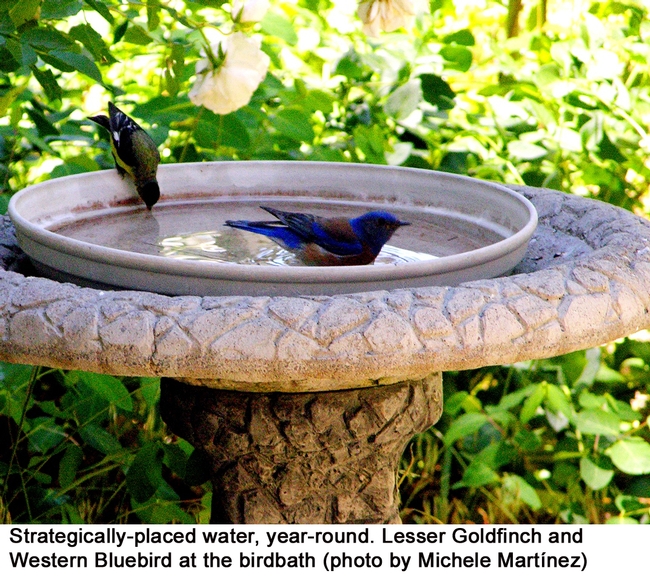
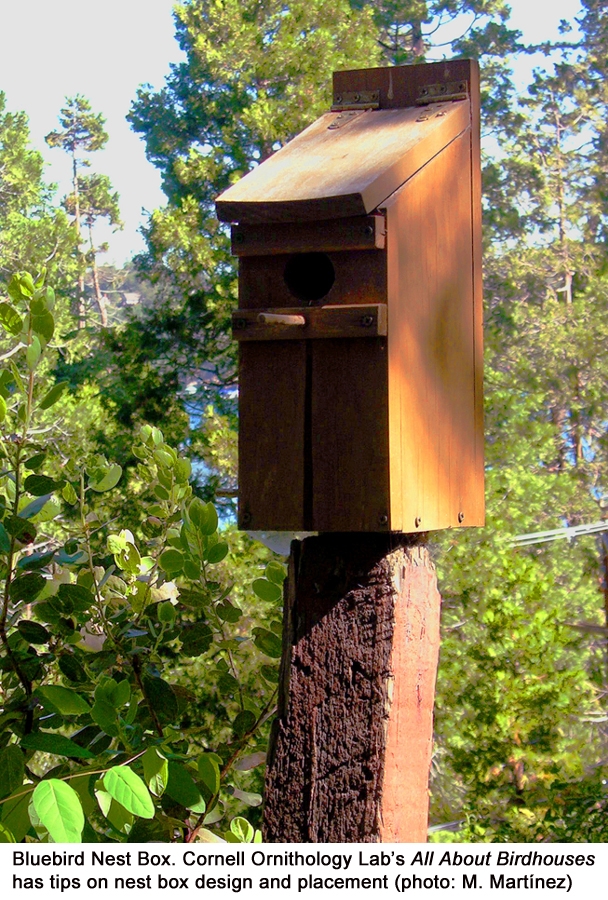
Read More:
“How to Create a Bird Friendly Yard,” by Rene Ebersole, Audubon Magazine (online):
http://www.audubon.org/magazine/july-august-2013/how-create-bird-friendly-yard
“Bringing Nature Home (web resource),” by Doug Tallamy
http://www.bringingnaturehome.net/gardening-for-life.html
Landscape Guide for Mountain Homes, LASCD. – An excellent handbook on drought-friendly landscaping for all of San Bernardino County, with native plant selections for both high-altitudes and lower elevations.
http://www.wrightwoodfsc.com/documents/landscape.guide.mountain.homes.pdf
Cornel Laboratory of Ornithology (Web Resource) – With information on birdhouses, migrating birds, and more.
http://www.birds.cornell.edu/Page.aspx?pid=1478
- Author: Michael Bains
I've read many a blog post explaining how to go about doing something, prepping something, etc with explicit instructions, but then never saw a follow up post on how things were going. Which leads me to believe that the poster never did what they proposed to do or it all went pear shaped and they'd rather not talk about it. It's entirely possible that life just moved on, but I like some follow up. Good, bad or indifferent.
Back in April I did a post on planning a cut flower garden. It was a garden I was going to put in my own yard using 2 4x8 foot raised beds I had previously used to grow vegetables. I did fail to mention that one of the reasons I was abandoning the vegetables was that I was fighting a losing a war against the Squirrel Hoards of Chino Hills. And my secret weapon, a Labrador Retriever, turned out to be completely useless in the fight.
I direct seeded six different flowers. Here are the results:
Sweet Peas Lathyrus odaratus – You don't see these. They were on the far right. They popped up about 6 inches and just quit. Didn't die. Didn't grow. Just sat there. So, I ripped them out.
Sunflowers Helianthus – These are doing just fine in the back of the left bed. Get about 2 flowers per week.
Larkspur Delphinium – A few popped up. I got about 25% germination on these. Again, I get a couple of flowers per week.
Cosmos Cosmos bipinnatus – The ball of orange in the left bed. I get about a bunch a week from 2 plants.
Zinnia – These fill most of the bed on the right. I get a bunch or two per week and the more I cut them, the more they grow.
Globe Amaranth Gomphrena – Got absolutely zilch to come up. These do prefer to be started indoors, and I guess I just ended up proving that. Lesson learned.
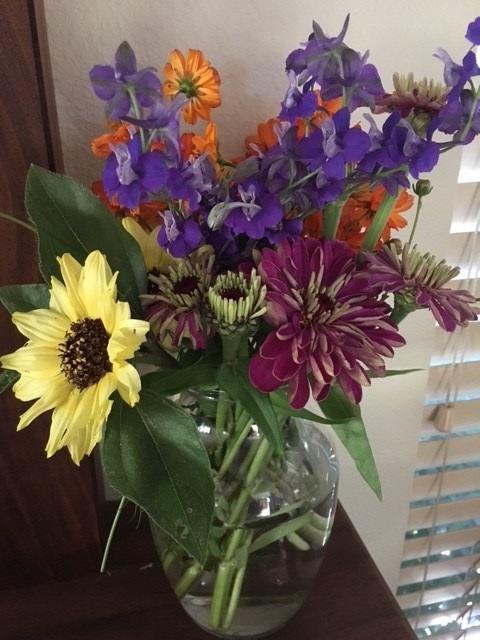
The only variety I continue to plant are sunflowers, these can continue to be planted until the beginning of August. Any later and you run the risk of cold weather setting in before the sunflowers have had a chance to bloom. I will start to turn the garden over in September and begin preparations for next spring. As noted in the previous article, I got a very late start this year, but hopefully this shows that even with a late start you can get some good results.
One change I did make to my original plan was to plant some basil, which I did in place of the Globe Amaranth. You can see the basil in the front of each of the two beds. Why basil? Because life without pesto just isn't worth living.
